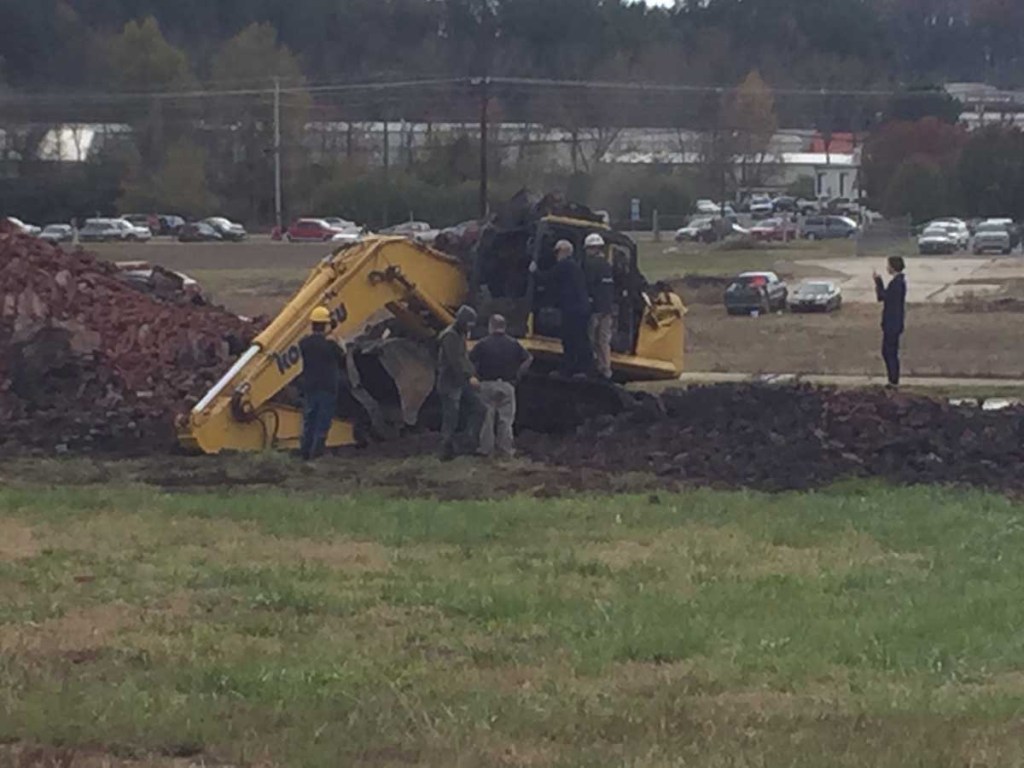UPDATE: Unknowns complicate smokestack demolition; driver okay after tower collapses on equipment
Published 9:00 am Wednesday, November 25, 2015

- The trackhoe, after the tower collapsed on it.
On Nov. 24 at 9 a.m., The first explosion cracked the silence, but the structure didn’t move. As bricks slowly crumbled at the base of the Avondale Mills smokestack, a chorus of “They don’t make ‘em like they used to” swept through the crowd that gathered around former mill property in Pell City.
It was almost an hour before the demolition company placed and set its second charge, and around 10 a.m. they hit the dynamite. Still nothing.
Trending
A call came out across the emergency channel that instead of setting another charge, demolition contractor Tim Phifer of Phoenix Services of Alabama was going to use track hoe to clear away earth and debris at the base of the smokestack. The audience of thousands reacted as Phifer, a Pell City resident, approached the structure and began chipping away at its base with a piece of heavy equipment.
“That is so stupid,” a woman said in the background. “He’s going get himself killed.”
Phifer removed a large portion of the tower’s brick exterior to reveal an inner support. Made of woven layers of brick mortared by concrete, the core refused to give way — even as the outer layer dwindled to nothing.
Then, with Phifer feet away, the tower fell the opposite direction of the plan and right onto the top of the track hoe. Right where Phifer was sitting.
“I just stayed inside the cab and rode it out,” he said, his clothes and skin coated in black soot except in some places where the scrapes could be seen. Phifer was removed and assisted by medical personnel and released.
City Manager Brian Muenger said it was Phifer’s decision to move the backhoe into harm’s way and that he was thankful no one sustained serious injury in the accident, but he acknowledged the morning’s result was less than ideal.
“Things definitely didn’t go as planned,” Muenger said afterward.
Phifer said he elected to set charges at the base of the tower after testing the upper regions.
“We didn’t know how the thing was made, but every time we drilled a hole up high it would go into chamber full of ash,” he said “It would been waste put an explosive there, so we tried to blow the bottom out.”
But each charge caused rubble to collect in the base and reinforce the core.
“It just kept filling in,” Phifer said.
When the dust settled, City officials walked the scene, the centerpiece of which was a buried piece of equipment. Chief of police Greg Turley located a section of the core to find out what had put up so much resistance.
“That’s what did it,” Turley said, holding a chunk of bricks that remained perfectly mortared even after the 150-foot tower collapsed on top of them.
As Muenger surveyed the site, he pointed to numerous bricks — the majority, really — that had no mortar attached at all. The smooth surfaces proved what previous studies had suggested. Years of erosion had removed the structure’s adhesive at the top. Even though it was slow to fall, it wasn’t safe, he said.
“This area is supposed to be a park someday, and in this condition the smokestack was certainly a hazard,” he said.
In the coming days, City crews will clean the site, and salvageable bricks — of which there are many — will be put on pallets and saved as officials decide a use for them. During the Council meeting on Nov. 23, Council President James McGowan suggested they be sold to raise money for future development on the site.
Council members appeared to like the idea, but no official decision has been made.


